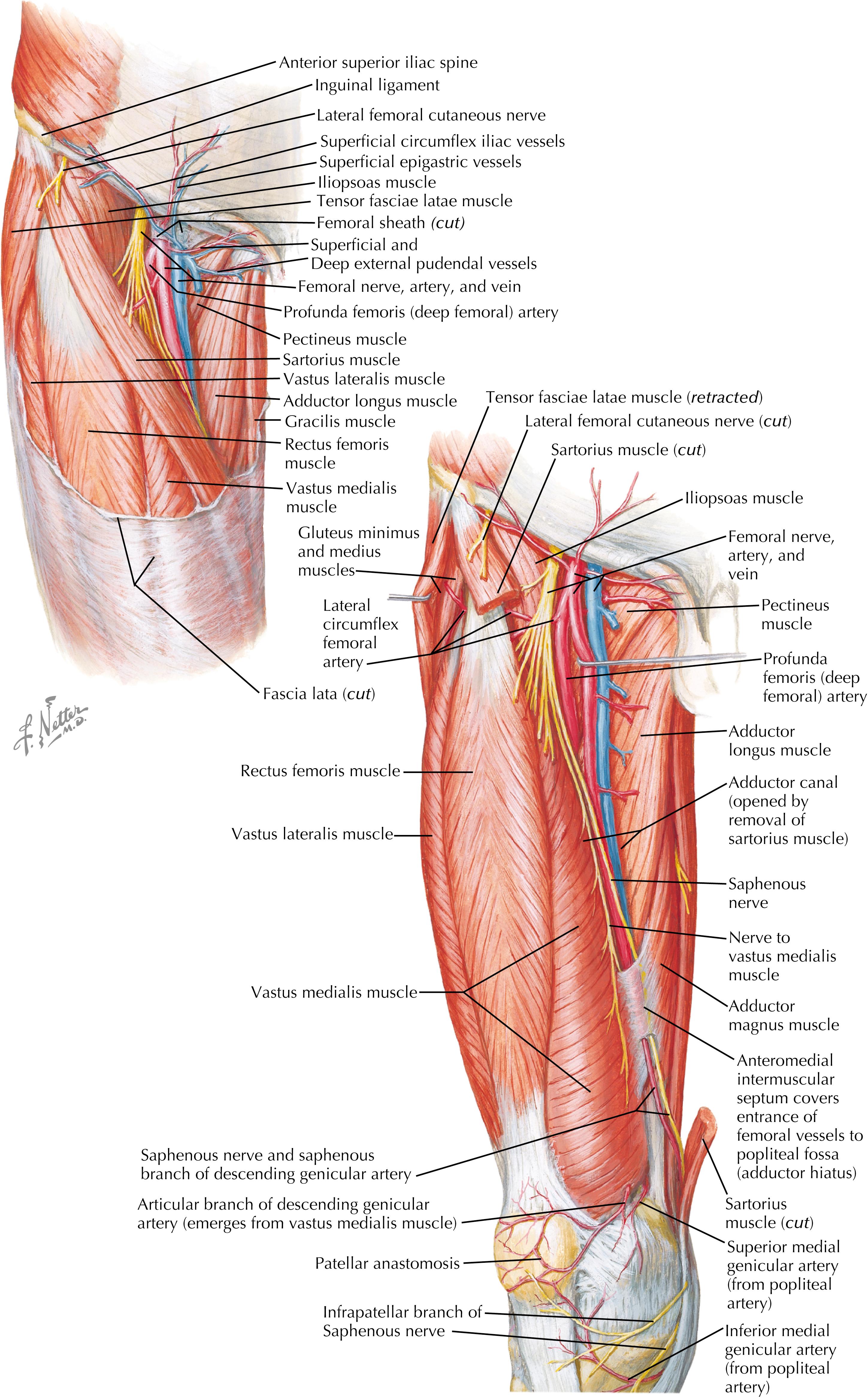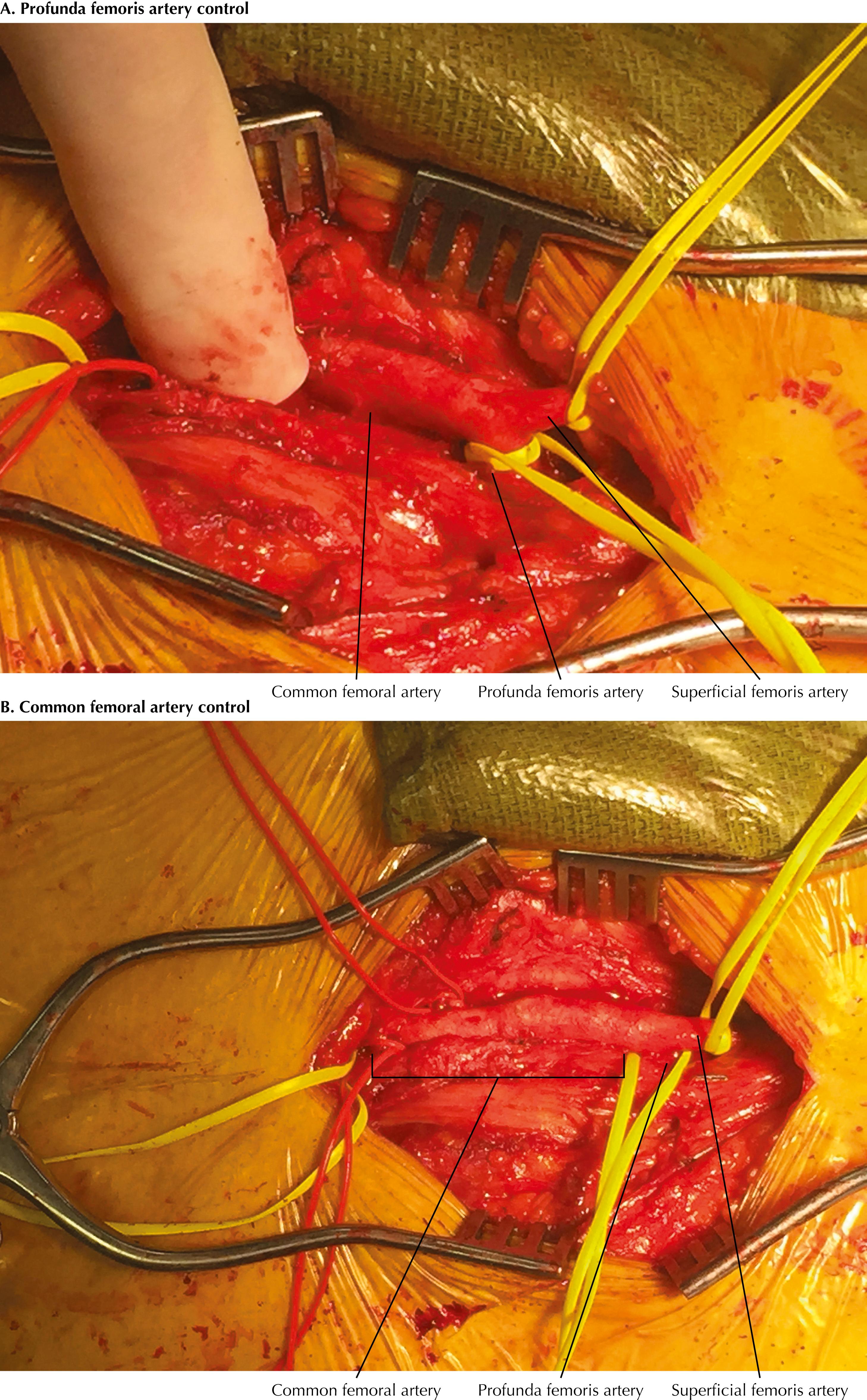Physical Address
304 North Cardinal St.
Dorchester Center, MA 02124
Infrainguinal arterial bypasses are major arterial reconstructions with the proximal anastomotic site below the inguinal ligament that are commonly used in the setting of chronic limb-threatening ischemia manifested by rest pain and/or tissue loss. The goal of these reconstructions is to provide inline arterial flow below the level(s) of the significant arterial stenosis or arterial occlusion. When a bypass is considered, it is imperative to evaluate the arterial inflow, bypass conduit, and arterial outflow to determine an operative plan that will optimize distal arterial perfusion and bypass graft patency. These bypasses can be created using autogenous, prosthetic, or cadaveric conduits, which have varying long-term patencies depending on the arterial inflow, site of distal bypass insertion, and arterial outflow. In this chapter, we focus on the anatomic exposure and techniques used for femoral artery to tibial arterial bypasses.
Adequate exposure of the proximal anastomotic site is imperative to ensuring a successful infrainguinal arterial bypass. This typically involves exposure of the common femoral artery, but the profunda femoris artery may also be used when trying to avoid the common femoral artery because of infection or to avoid a reoperative field. The superficial femoral artery is often too diseased to allow it to be a suitable candidate for the proximal anastomotic site of a femoral-tibial bypass, but it may be used in some settings, if necessary. For this chapter, we focus on exposure of the common femoral artery and profunda femoris arteries.
First, the patient is placed in the supine position. After the patient is shaved and prepped from the level of the umbilicus through the foot, the common femoral artery exposure is typically achieved through a vertical incision directly over the femoral pulse with two-thirds of the incision below the inguinal ligament and one-third of the incision above the inguinal ligament. The inguinal ligament is identified via a straight line from the anterior superior iliac spine to the pubic tubercle. The common femoral artery is usually approximately two fingerbreadths from the pubic tubercle. When there is no palpable pulse, a continuous-wave Doppler can be used to assist with identification of the femoral artery location. If there is no Doppler signal, the vertical incision should be made just medial to the middle of the inguinal ligament. Typically the diseased vessel can be palpated by rolling fingers over the location to feel the hardened longitudinal tube structure through the skin. Oblique incisions may be used because they may decrease wound complications, but these typically limit the exposure needed for bypass creation. If any oblique incision is to be made, it is parallel and just above the groin crease. Once the incision has been made, the incision is deepened through the Camper’s and Scarpa’s fascia. At this point, the superficial inguinal lymph node lymphatics as well as the superficial epigastric and superficial circumflex iliac vessels are encountered. Lymphatic tissue should be carefully divided and ligated to decrease the risk of future lymphocele formation. One may also divide the superficial epigastric and circumflex iliac vessels when deepening the incision toward the common femoral artery. Once the lymphatic tissue has been divided, the fascia lata is encountered.
The fascia lata is opened vertically on the medial border of the sartorius muscle. The sartorius muscle is retracted laterally, and the proximal aspect of the incision is extended cephalad until the inguinal ligament is identified. Once identified, the inguinal ligament is freed up from the surrounding tissue. At this point, the femoral sheath is identified at the bottom of the incision and opened vertically on top of the common femoral artery. Once the femoral sheath is open, the common femoral artery should be dissected out from the surrounding areolar tissue to allow for arterial control to be obtained. When attempting to obtain proximal common femoral artery control, the surgeon must try to identify the deep circumflex iliac vein, commonly referred to as the “vein of sorrow” or “vein of pain,” which usually crosses the very proximal common femoral artery or distal external iliac artery. Identification and ligation of this vein allow for more proximal arterial control, but its ligation can also help avoid significant venous bleeding that can be difficult to control during the initial or a subsequent common femoral artery exposure. A right angle can be used to pass a silicone vessel loop twice around the proximal aspect of the vessel to ensure adequate proximal arterial control has been achieved. The common femoral vein is immediately medial to the common femoral artery, and conscientious care should be taken to avoid inadvertent injury to the vessel during dissection and while obtaining control of the common femoral artery ( Fig. 47.1 ). After obtaining proximal common femoral artery control, the surgeon uses dissection along the anterior surface of the common femoral artery until a caliber change is noted in the artery. This approach helps to avoid injury to the profunda femoris artery and branches off the common femoral artery. The caliber change in the common femoral artery identifies where the common femoral artery bifurcates into the profunda femoris artery and superficial femoral artery.

The profunda femoris artery typically is identified posterior and lateral to the common femoral artery. During the isolation of the profunda femoris artery, it is imperative to avoid injuring the lateral femoral circumflex vein, which often crosses anterior to the proximal aspect of the profunda femoris artery and can be easily injured during dissection. Dissection of the profunda femoris artery should be extended distal to the extent of arterial disease to allow for potential endarterectomy of the artery, if needed. This may require dissection of the profunda femoris artery to its second or third order, but it is crucial to ensure that the surgeon performs the anastomosis to a disease-free vessel. For dissections that require extension to the second or third order of the profunda femoris artery, it is imperative to identify the main profunda femoris vein and avoid its ligation because there will be many small crossing veins at this level that will likely require ligation for adequate exposure of distal profunda femoris artery. For details on femoral endarterectomy, see Chapter 46 , Femoral Endarterectomy and Femoral Popliteal Bypass. After the profunda femoris is controlled with a silicone vessel loop, the superficial femoral artery can be dissected out to control the proximal portion of the artery with a silicone vessel loop ( Fig. 47.2A ). Care should be taken to obtain control of all branches off the common femoral artery before opening the common femoral artery because there can be significant back bleeding from uncontrolled branches ( Fig. 47.2B ). Once adequate control of the common femoral artery has been obtained, a moistened sponge can be placed into the incision, and attention can be turned to the posterior tibial artery dissection.

Become a Clinical Tree membership for Full access and enjoy Unlimited articles
If you are a member. Log in here